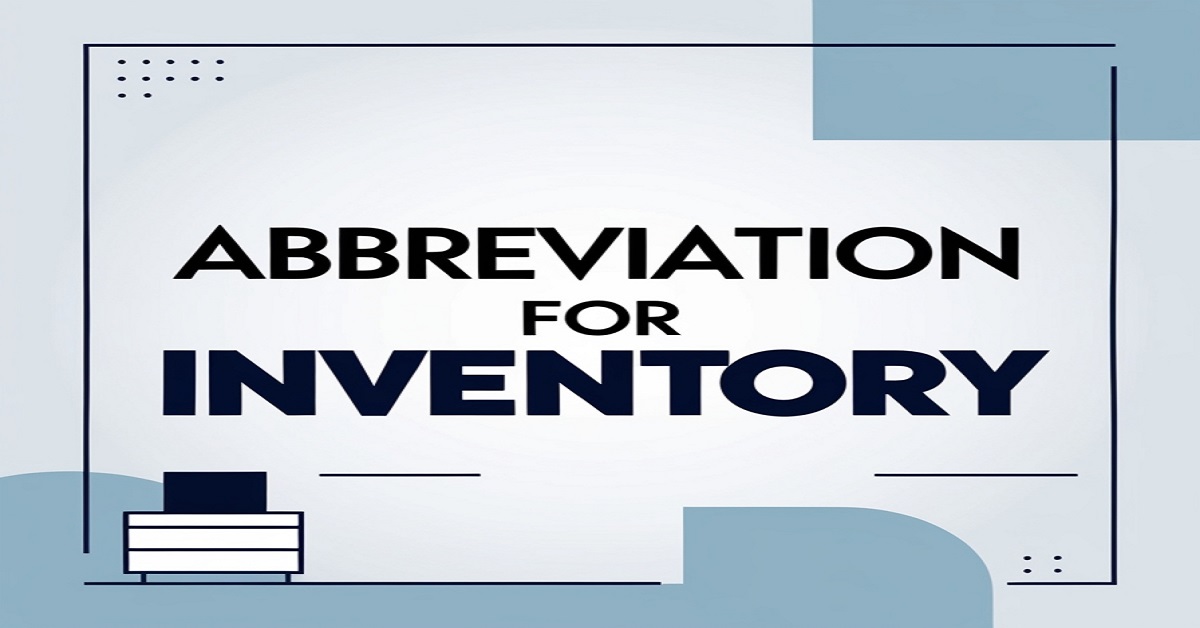Efficient communication is at the heart of successful inventory management. Across industries, inventory is a term that resonates in every corner of business operations, whether in warehouse management, supply chain, or retail inventory. And while the concept itself is universally understood, the shorthand used to refer to inventory—INV—is critical in speeding up operations, especially when dealing with complex systems. But what exactly is the INV abbreviation, why is it used, and how can it enhance your business operations?
Let’s dive deep into the world of inventory management, INV, and how abbreviations in general streamline the process.
What is the Abbreviation for Inventory?
At its most basic, the abbreviation INV stands for “inventory.” In simple terms, inventory refers to the goods and materials a company holds for resale or use in production. The INV abbreviation is used in several ways across industries, especially in businesses that need to track, manage, and control their stock efficiently.
Whether you’re managing an e-commerce store, a manufacturing company, or a large warehouse, you’ll find that INV is used regularly across inventory management systems to track stock, report on inventory turnover, and measure other important metrics like inventory valuation and stock levels.
Why Use Abbreviations for Inventory?
The primary reason for abbreviating “inventory” to INV is efficiency. When dealing with large amounts of stock or complex data, businesses need tools that can streamline processes and make communication quicker. Here are some reasons why abbreviating inventory to INV is so beneficial:
- Quick Data Entry: Whether entering data into a spreadsheet or an inventory management system, using INV saves time. Typing “inventory” repeatedly can become tedious, and using INV minimizes the risk of repetitive strain injuries for warehouse workers, administrative staff, and other team members who frequently type.
- Simplicity in Communication: In environments where time and space are limited, such as in logistics meetings, using INV to refer to inventory helps cut down on unnecessary words. It’s especially useful in informal settings like team communications or internal reports.
- Space Saving: When dealing with reports that contain long lists of data, abbreviations like INV help save space. This is particularly important in business reports and financial reports, where every inch of space is valuable.
- Standardization: Using INV helps standardize communication across teams. It ensures that everyone involved in inventory-related processes is on the same page. For example, a report might use INV to indicate the total stock available or the inventory turnover rate.
What Does the Abbreviation for Inventory Mean?
The INV abbreviation is a simple yet crucial shorthand. It stands for inventory, which encompasses the goods, raw materials, and finished products a business holds for resale or manufacturing. This can include:
- Raw materials: Materials used in production but not yet transformed into finished goods.
- Work-in-progress (WIP): Items that are in the process of being manufactured but aren’t finished products.
- Finished goods: Items ready for sale.
In inventory management, INV is used in various contexts such as inventory tracking, inventory audits, stock levels, and inventory turnover metrics. Whether you’re analyzing inventory valuation or working on an inventory forecasting model, INV remains a shorthand tool used to make these processes more efficient.
How to Write “Inventory” in Short Form
When it comes to shortening the word inventory, the most universally accepted abbreviation is INV. It is widely used in databases, spreadsheets, and even physical logs to represent inventory management tasks. Here are some contexts where INV would be used:
- INV Report: A document or summary report that outlines the current state of stock levels.
- INV Number: A unique identifier associated with specific inventory items for tracking purposes.
- INV Turnover: A metric used to measure how often the company sells and replaces its inventory.
- INV Valuation: The calculation of the monetary value of a business’s inventory at a particular point in time.
By utilizing INV, businesses can shorten lengthy tasks related to inventory tracking and management.
Acronyms vs. Abbreviations: Understanding the Difference
It’s important to note that INV is not an acronym but an abbreviation. This distinction is important because:
- Abbreviations are shortened forms of words, such as INV for inventory.
- Acronyms, on the other hand, are formed from the first letters of a phrase to create a new word (e.g., FIFO for “First In, First Out”).
In the case of inventory, INV is simply a shorter way to refer to the word inventory, not a collection of initials that create a pronounceable word.
How to Pronounce “Inventory” and Its Abbreviation
The pronunciation of inventory is relatively straightforward: /ˈɪn.vənˌtɔː.ri/ (in-ven-tor-ee). However, the abbreviation INV is pronounced by saying each individual letter: “I-N-V.” This is crucial in settings like meetings or reports where quick and clear communication is essential.
The use of INV eliminates the need to say the full word inventory, saving time, especially in fast-paced environments like warehouses or retail spaces.
How to Use INV Effectively in Documentation
Using INV in your inventory documentation requires consistency and clarity. Here are some best practices for using INV effectively:
- Standardize Its Use: Always use INV after the first mention of “inventory” in any document. For example, the first time inventory is mentioned in a report, write it out fully: “inventory (INV).” Afterward, you can use INV in place of the full word throughout the document.
- Provide Context: While INV is efficient, sometimes it’s useful to add a little context for clarity. For example, “The INV turnover for this quarter was 25%, meaning we sold and replaced 25% of our stock.”
- Limit Overuse: If you’re creating a report for an external audience or someone unfamiliar with the inventory management process, avoid overusing INV. It’s important that the meaning is clear, so balance your use of INV with its full form to avoid confusion.
- Ensure Consistency Across Documents: In business environments where multiple people are involved in inventory control, it’s essential to maintain consistent usage of abbreviations. This ensures that everyone interprets the data the same way.
The Role of Abbreviations in Modern Inventory Management
Abbreviations like INV play an essential role in modern inventory management systems, which track everything from raw materials to finished products. These systems use abbreviations in their interfaces and reports to make inventory data easier to process. In inventory tracking software, you may encounter:
- SKU (Stock Keeping Unit): Unique identifiers for products.
- FIFO (First In, First Out): A method for managing stock in which older items are sold first.
- LIFO (Last In, First Out): The opposite method where the newest stock is sold first.
These abbreviations and others streamline the process of monitoring and adjusting inventory levels, ensuring better organization and efficiency.
Synonyms for Inventory and Its Abbreviation
In addition to “inventory,” several synonyms can be used to refer to the same concept, depending on the context:
- Stock: Commonly used in retail environments to describe items available for sale.
- Catalog: Refers to a list or inventory of goods, especially in retail settings.
- Supply: A more general term that can also refer to inventory or goods on hand.
- Goods: Often used in business settings to refer to items that are manufactured or sold.
However, when you’re using INV to refer to “inventory,” it’s important to note that not all synonyms may always be interchangeable. For instance, stock usually refers to finished goods for sale, while inventory may also include raw materials and work-in-progress.
When and Where to Use the Abbreviation for Inventory
The INV abbreviation can be used effectively across various sectors and contexts, including:
- Inventory Management Software: Systems used to track and control stock levels.
- Financial Reports: Documents where stock valuation, turnover, and other metrics are measured.
- Warehouse Management: Tracking stock movements, quantities, and storage conditions in warehouses.
In environments like e-commerce or retail, where inventory movements happen quickly, using INV helps speed up processes and minimize the chances of errors in data entry.
Examples of INV in Context
Here are some examples of how the INV abbreviation can be used:
- “The INV turnover rate for the last quarter was 18%, indicating a healthy stock rotation.”
- “Please update the INV number for the new stock shipment in the system.”
- “We have a surplus of INV in raw materials, so we’ll need to adjust our inventory valuation.”
These examples highlight the versatility and usefulness of INV in daily business operations.
Other Related Terms in Inventory Management
There are many key terms related to inventory management that also use abbreviations, such as:
| Term | Definition |
|---|---|
| SKU (Stock Keeping Unit) | A unique identifier for each product or item in your inventory |
| FIFO | First In, First Out: An inventory management system |
| LIFO | Last In, First Out: A reverse inventory system |
| EOQ | Economic Order Quantity: The optimal amount to order for cost efficiency |
These terms, alongside INV, are vital to understanding how businesses manage inventory, maintain stock levels, and analyze inventory metrics.
Final Thoughts
In conclusion, the INV abbreviation is an essential tool in inventory management, used to simplify communication, save time, and enhance efficiency. Whether you’re working with inventory software, preparing financial reports, or simply tracking stock in your warehouse, INV is a shorthand that can help streamline your operations and increase clarity.
By embracing INV and other abbreviations like FIFO and SKU, businesses can manage their inventory control more effectively, ensuring smoother supply chain management and optimized stock levels. Understanding when and how to use INV in documentation is key to ensuring that your inventory management processes are both efficient and accurate.
Incorporating the INV abbreviation into your business operations will help you stay organized, save time, and communicate more effectively within your team, driving better results in inventory tracking, logistics, and overall business efficiency.

Tony James is a passionate wordsmith and the creative force behind Winky Hive. With a knack for uncovering the stories behind slang and weaving emotions into poetry, Tony brings a unique voice to every piece he writes. A lifelong lover of language, he thrives on exploring how words evolve, connect, and inspire.
When he’s not penning articles or crafting verses, Tony enjoys diving into cultural trends, reading classic poetry, and discovering hidden gems in modern expressions. His mission? To make Winky Hive a haven for those who love the art of language in all its vibrant forms.









